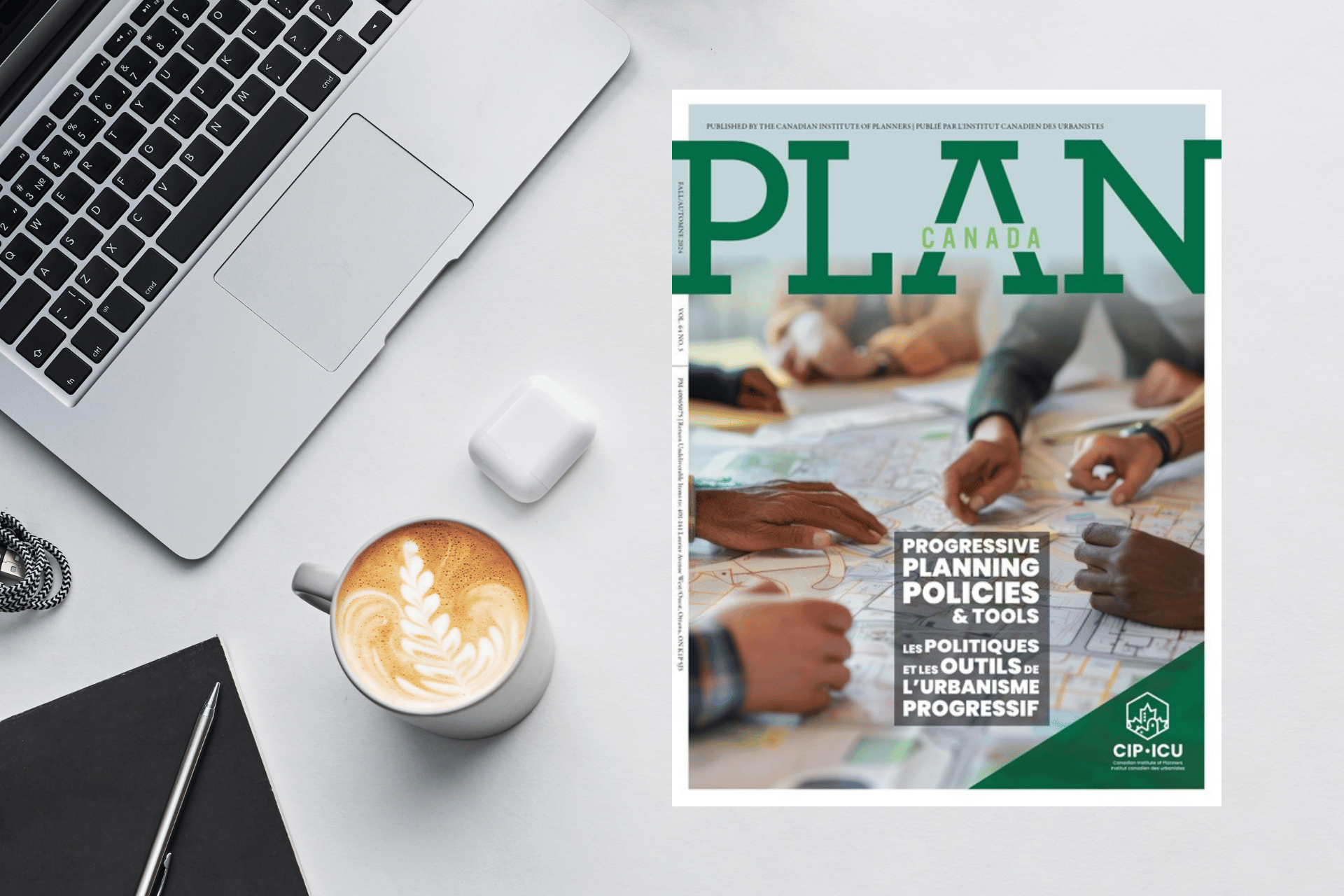Editors’ Note by Ezra Wasser and Rylan Graham
Planners are called upon to shape the futures of our communities. To get the job done, planners rely on an assortment of tools, including policies, bylaws, standards, and guidelines. These documents put the ‘plan’ in ‘planning.’ Nevertheless, the ‘what’ and the ‘how’ of planning are constantly evolving.
The Fall 2024 issue of Plan Canada is intended to share, illuminate, and discuss progressive planning policies and tools that planners throughout the country are using to shape Canada’s communities. This issue’s contributors have shared their ideas, strategies, toolkits, experiences, and general lessons learned on how to collaboratively advance policies that result in sustainable, healthy, equitable, and inclusive communities.
The Canadian Institute of Planners’ vision is to facilitate the development of “inclusive and vibrant communities, respectfully connected to the natural world, for the well-being of current and future generations.” The policies that our members formulate are reflective of this aspirational statement.
As we aim to benefit the entirety of the populace, we need to consider its diversity. To help planners consider how to achieve this important goal, Neal LaMontagne provides an outline of the many spectra to contemplate when developing policies.
While policies reflect ideals, they also need to be practical for their intended outcomes to be realized. Policies need to be implementable in a transparent and efficient manner, as well as mutually agreeable to development authorities, the development industry, and the public. Pam Shaw and colleagues promote this ideal of practicality by creating a set of best practices to make development application review and decision-making processes efficient, effective, purposeful, and productive.
Policies guide change in our communities, which can be uncomfortable, daunting, disorienting, and otherwise impactful. Is it possible that change could be a welcomed outcome from the perspective of a community? Samantha Murphy, Michelle L. MacDonald, and Wendy Watts write about how the Town of Stratford on Prince Edward Island has launched an innovative digital platform to encourage community involvement and build support for new housing initiatives.
Good policies are based on good data, and long-range planning requires an understanding of present conditions. Barb Besner and Hillary Rosentreter share how United Way Winnipeg and the International Institute for Sustainable Development have worked collaboratively to collect and share data to inform charitable investments and policy-making decisions by the City of Winnipeg.
The City of Edmonton is seeking to integrate these aforementioned ideals, take risks, and set new standards. Trevor Illingworth and Jennifer Renner document the creation and adoption of the City’s new zoning by-law. In this article, the authors discuss efforts to construct a zoning bylaw that can help build a better future.
To enable a better future, planners need to create a policy framework that responds to the climate change and housing supply crises. Amelia Needoba, Camille Lefrançois, Zhaohua (Cindy) Cheng, and Cassandra Cummings identify the challenges and opportunities with conserving natural systems while unlocking new housing, and demonstrate that these concerns can be addressed simultaneously. Meanwhile, Doug Marakoff and Deb Morse offer a series of thought-provoking ideas to conserve natural features while responding to the pressures of population growth – ensuring that development is environmentally and economically sustainable.
Next, Andreanne Doyon, Anwen Rees, and Moe Nadeau provide their findings from an analysis of 160 Official Community Plans from municipalities between the Rocky Mountains and the Pacific Ocean as they progress towards enshrining reconciliation with Indigenous Peoples.
This issue concludes on a meta note as Lisa D. Orchard discusses the advantages of planners taking the time to set ‘house rules’ for copy editing, and reflects on the possible consequences of lacking guidelines when writing guidelines.
Policies, bylaws, standards, and guidelines are the core of what we do as planners. Creating and abiding by these plans is how our societies coordinate large numbers of people to work towards achieving mutual goals in geographically vast, populous, and complex organizations. Accordingly, planners need to be both ambitious and pragmatic, and their plans need to be both visionary and implementable.
We encourage you to reflect upon what ‘progressive’ means to you as you use, create, and critique policies, bylaws, standards, and guidelines. We hope you appreciate reading this issue’s articles about ideas and initiatives from your colleagues across the country. Likewise, we believe that these articles will be informative and inspirational to those of you who are shaping the next generation of plans for our ever-evolving communities.
How to Read This Issue of Plan Canada
Are you a CIP member?
Not a CIP member?
About the Editors
Ezra Wasser RPP, MCIP
Plan Canada Editorial Committee
Ezra is a registered professional planner and a project manager with the City of Toronto. Prior to joining the City of Toronto team, he worked as a planner with the City of Calgary. Ezra is a graduate of the University of Waterloo School of Planning, is currently pursuing a graduate diploma in public administration in the Local Government Program at Western University, and volunteers with the Toronto District of the Ontario Professional Planners Institute.
Rylan Graham PHD, RPP, MCIP
Plan Canada Editorial Committee, Co-chair
Rylan Graham is an Assistant Professor in the School of Planning and Sustainability at the University of Northern British Columbia. Rylan’s research focuses on issues related to growth management, intensification, downtown revitalization, and with a particular focus on mid-sized Canadian cities. Rylan has a PhD from the University of Calgary, a Master of Arts, Planning from the University of Waterloo, and a Bachelor of Arts, Geography from the University of Regina. Prior to entering academia, he practiced as a planner in Alberta and Saskatchewan.
